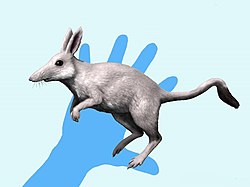Classification
The specimen was originally referred to Deltatheroida, a clade of carnivorous metatherians rather common in the Cretaceous of Asia. [8] However, one study by Guillermo Rougier has found it to lack the group's synapomorphies and instead resemble the American stagodontids more closely. [2]
Posterior phylogenetic studies have indeed recovered this specimen as being closer to the Marsupialiformes line than to Deltatheroida. However, instead of being close to stagodontids, the Gurlin Tsav skull usually groups outside of a clade leading to South American metatherians (and, consequently, to marsupials). It is nearly always an immediate outgroup to sparassodonts. [1] [2] [4]
Most recently, it has been found to group with sparassodonts and other Paleocene non-marsupial metatherians from South America. It and these taxa from a group independent from not only Deltatheroida, but also a North American clade where true marsupials are nested as well as stagodontids. [4]
This page is based on this
Wikipedia article Text is available under the
CC BY-SA 4.0 license; additional terms may apply.
Images, videos and audio are available under their respective licenses.




